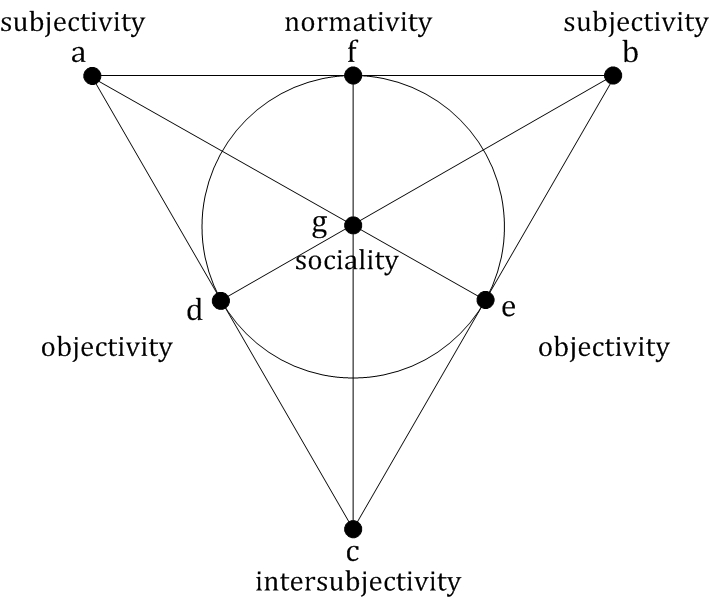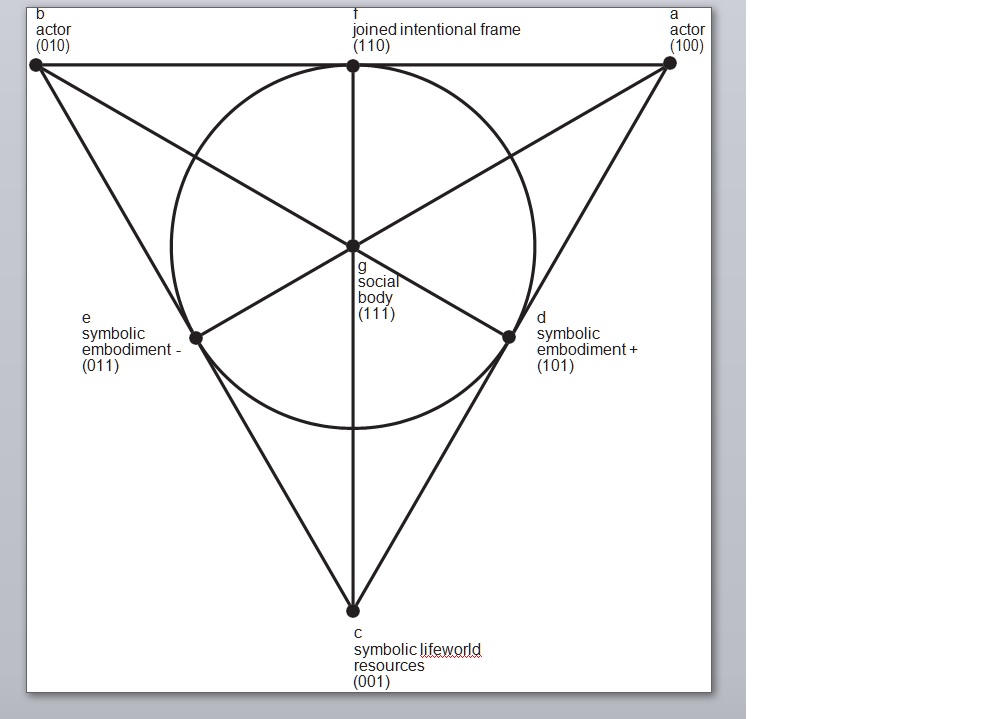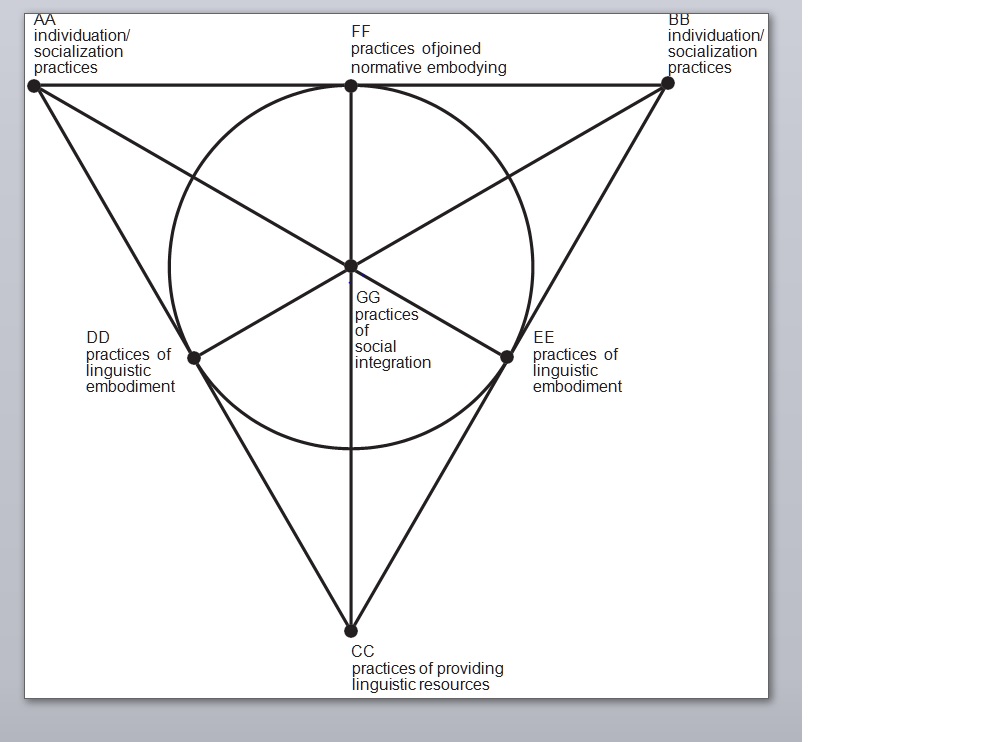Summary.
Habermas’s theory of society has given important incentives to the analysis of the relation between scientific and everyday problem-solving in several social-scientific disciplines. In this paper I intend to show how the structuring conceptual network of his theory can be reconstructed with the use of mathematical means. Step by step conceptual constructs are designed. The result thereof is a scaffolding set of four, systematically interlinked, models. Two of them are capacity-focused. They articulate the general underlying conceptual structure of Habermas’s theory of society. The other two represent elaborations of this categorical framework: one action-theoretic and the other system-theoretic. They are performance oriented and context specific. My claim is, that the performance oriented models can be operationalized and made measurable for research purposes (heuristically, hermeneutically and experimentally).
Habermas’ set of basic general concepts
In line with Habermas’s conception of a theory of society, and supplementing his terminology, I consider the following set of general concepts as indispensable: subjectivity, objectivity, normativity, intersubjectivity and sociality. To avoid getting lost in the complexity of the conceptual network in which these five general concepts function, I have used for my reconstruction a mathematical model (cf. dissertation v.Doorne 1982 and v.Doorne 1997). One can find here all the details about a tripolar interaction model, that I have transformed , in close cooperation with Pieter Ruys, into a tripolar model of social interaction.). Making use of the tripolar model it is possible to represent the conceptual coherence of the five concepts as follows :
Figure 1a: coherence of general concepts
The suggestive presentation of the five concepts by the lines of Figure 1a becomes philosophically meaningful only by the assumption, that the definition of the general concepts is determined through the interaction of their meaning-components, represented by the positions (Figure 1b). I consider my interpretation and my wording of it as consistent with Habermas’s conception of social interaction. Most of the main reference texts I am building on have been collected by Maeve Cook in On the Pragmatics of Communication (Habermas 1998).
1.When, indeed, each position can be interpreted in terms of a meaning-component, then the meaning of each of the general concepts of Habermas’ theory of society is defined by the interaction of three meaning-components (see Figure 1b). I call the concepts used to characterize them ‘primitive’ concepts. They express Habermas’s intuitions concerning the indispensable and irreducible components that we have to assume in order to adequately understand and define the five general concepts.
Figure 1b: naming and representing capacity-components
(P.M. add to resource capacity: of embodiment)
In order to be able to define Habermas’ general concepts in a pragmatic sense the ‘primitive’ concepts have to be conceived as referring to capacities. Each position representing a capacity is itself a connective point of three lines. It means that each position, being the intersection of three lines, is characterized by three capacity-aspects that have to be enumerated specifically. Thus, there are 3 x 7= 21 capacity-aspects. Each capacity is in three ways involved in the conceptual interaction-structure to be articulated: e.g. capacity a as part of three lines: (a,d,c), (a,g,e) and (a,f,b); and so on for all capacities. I will use subscripts for the capacity-aspects. In Table 1 I give an overview of the ‘primitive’concepts I use for the capacities and their aspects.
Table 1: overview of ‘primitive’ concepts
capacity-aspects of the separate positions a,b,c
* a and b agent capacity imply the aspects of
a.
. a1 ‘self’ relating
. a2 ‘other’relating
. a3 design
b.
. b1 ‘self’relating
. b2 ‘other’relating
. b3 design
* c resource capacity of embodiment implies resource-aspects of
c.
. c1 ‘self’relating embodiment of a1/’other’ relating embodiment of a2
. c2 ‘self’relating embodiment of b1/’other’ relating embodiment of b2
. c3 coordinated embodiment of a3 and b3
capacity-aspects of the intermediate positions d,e,f
* d and e embodiment capacity ( in the sense of linguistic articulation) implies the aspects of
d . d1 ‘self’relating embodiment a1
. d2 ‘other’ relating embodiment b2
. d3 equivalent (‘mirrored’) embodiment a1 and b2
e . e1 ‘self’ relating embodiment b1
. e2 ‘other’ relating embodiment a2
. e3 equivalent (‘mirrored’) embodiment b1 and a2
* f correlate capacity implies the aspects of
f . f1 correlating designs of a3 and b3
. f2 correlating the ‘self’ relating embodiment of d1 and e1
. f3 correlating the ‘other’ relating embodiment of d2 and e2
capacity-aspects of the integrative position
* g integrate capacity g implies aspects of
. g1 integrated embodiment of c3 and f1.
. g2 integrated embodiment of a2 and e2
. g3 integrated embodiment of b2 and d2
2. I move on now step by step to levels of concept formation that allow to develop concepts fit to be used for the approach and articulation of empirical everyday social interactions. The concepts we are looking for have to refer to the factual multidimensional reality we are living in nowadays. This complex reality includes, on the one hand, a multitude of interactions and interaction opportunities between agents, but, on the other hand, manifests itself in numerous interactions of potentials, structures, opportunities and processes with their own weight and their own course of development. This means that for a conceptual articulation of the characteristics of social relations, only a theoretical reconstruction will suffice that is rich enough in terms of differentiating conceptual tools. It has to articulate the differences of meaning as well as the interconnectedness of interactions between agents and interactions between social domains
To reconstruct the complex conceptual framework of Habermas’s theory an intermediate construct is required to make systematically the transition from the model of capacities towards the model of actual interactions between agents. The model presented in Figure 2 shows therefor the constitutive conceptual features that have to be assumed in order to understand and define the social practices that Habermas distinguishes. The concepts used for the model do not yet refer immediately to empirically discernable social phenomena. E.g., we cannot identify a human being as a social agent separate from the practices he/she is involved in. It is precisely in view of this pragmatic context, that I call the underlying conceptual features carriers of capacities for social practices. In Table 2 I will enumerate these carriers and define them with the help of the already acquired notions, thus elucidating their conceptual complexity. To name them I have chosen a terminology that is close to that of Habermas.
It would take more space than available to write down verbally in full length in the Tables 2, 3, and 4 the introduced concepts, as is done in Table 2 for the agent-concept of the two carriers of potentials A and B. For the rest I limit myself to giving only the coded definitions of the positions and their specifications.
Figure 2: the carriers of potentials
Table 2: the carriers of potentials for social practices defined
carriers of the separate potentials A, B, C
* actor A and B, carrier of capacity for initiating interactive relations
. A1(a1,d1,c1), resp. B1(b1,e1,c2): initiating expressive action drawing upon available resources.
. A2(a2,e2,g2),resp. B2(b2,d2,g3): initiating confronting action regarding other’s embodying
. A3(a3,f1,b3), resp. B3(b3,f1,a3): initiating correlating his/her design with the design of an other.
* symbolic lifeworld resources C, carrier of capacity for embodying interactive relations.
. C1 (c1,d1,a1).
. C2 (c2,e1,b1)
. C3 (c3,f1,g3).
carriers of the intermediate potentials D,E,F
* symbolic embodiment D and E , carrier of capacity for ‘self”-relating and ‘other’-relating embodiment
. D1(d1,a1,c1), resp. E1(e1,b1,c2).
. D2(d2,b2,g2), resp. E2(e2,a2,g1).
. D3(d3,f3,e2), resp. E3(e3,f3,d2).
* joined intentional frame F , carrier of capacity for correlating designs
. F1(f1,a3,b3)
. F2(f2,d1,e1)
. F3(f3,d2,e2)
carrier of the integrating potential G
* correlated embodiment G, carrier of capacity for constituting a social body
. G1(g1,a2,e2)
. G2(g2,b2,d2)
. G3(g3,c3,f1)
3. The model of Figure 1b represents the interaction structure of the conceptual meaning components that are taken to be constitutive for whatever social frame of reference regardless of time and place. The same holds true for the model of Figure 2 that represents the constitutive conceptual features of social practices. The theoretical claim is that the meaning components and the carriers of capacities are general. ( I feel encouraged to defend this position by Habermas’ analyses in his most recent text on the topic (Habermas 1999, Einleitung, 7-64), in which he reconstructs the underlying linguistic-pragmatic structure of social interaction.) A similar claim cannot be maintained for the models that characterize the two complementary elaborations that follow. For they have to be linked up contingently, in their conceptual interpretation as well as in their material reference, to specific interaction situations located in historic time and geographical space. These two models are represented in Figures 3 and 4.
According to Habermas, there is a need for two elaborations of the above articulated conceptual structure given today’s societal context (Habermas 1983 and 1998, 164-174;187-255, in particular 215-255). One focused on interactions between agents which are accessible from within the perspective of participants in the interaction. Experiences are situated in this context (Habermas 1998, 191, 246 and passim) as well as reflexive analyses thereof. The other focused on interactions between domains which are not directly accessible from within, but only through observation and reconstructive-empirical analysis. They concern what Habermas calls ’the perspective of the lifeworld’, that is, of the background resources of social interactions. In his view the two elaborations complement each other and are of equal importance for the development of an adequate contemporary theory of society. Ultimately, social interaction is defined through the double-sided interaction pattern of the social practices AND of the social domains. The interconnectedness of the two elaborations is secured by the fact that they have the same underlying conceptual structure. In other words, they are structurally isomorph. I note that this double-sided interaction pattern is a philosophical interpretation of the property of duality characteristic for the mathematical model of tripolar interaction. One could say that the two elaborations address a different layer of the same interaction processes ( ibid. 239-255). I consider this isomorphy as systematic input into the formation of the differentiated conceptual tools. It is the linking pin between different levels of conceptual complexity.
4. First, I will introduce the concepts required by an action-theory from the theoretical perspective focused on the interactions of agents , to be called practices. And second, the concepts required for a theoretical perspective focused on the interactions of the domains (more or less institutionalized social subsystems) in which the interactions between agents are embedded.
As regards the action-theoretic elaboration, we have to reckon with a double-sided interactive pattern: the pattern of the carriers of capacities of societal practices AND the pattern of the interactions of the practices themselves. The model of the first pattern has been shown in Figure 2, and has been defined and specified in Table 2. The model of Figure 3 represents the overall interaction structure of contemporary social practices that are empirically identifiable, and for which it is possible through aptly chosen empirical specifications to measure and count their respective weights in an actual social practice. In Table 3 I will define and specify conceptually the social practices. They designate the first part of the appropriate context that Habermas considers as the bench mark for all our approaches of social interactions, be they common in everyday life or scientific ones. The empirically identifiable network of social practices is the integrated actualization of the capacities enumerated in Table 2.
Figure 3: interaction structure of social practices
Table 3: the social practices defined
three separate social practices AA , BB , CC
* AA, resp. BB practices of identification
. (AA)1: (A1,C1,D1), resp. (B1,C2,E1).
. (AA)2: (A2,E2,G2), resp. (B2,D2,G3).
. (AA)3: (A3,B3,F1), resp. (B3,A3,F1).
* CC practices of providing linguistic resources
. (CC)1: (C1,A1,D1).
. (CC)2: (C2,B1,E1).
. (CC)3: (C3,F1,G3).
three intermediate social practices DD, EE, FF
* DD, resp. EE practices of linguistic embodiment
. (DD)1: (D1,A1,C1), resp. (E1,B1,C2)
. (DD)2: (D2,B2,G2), resp. (E2,A2,G1)
. (DD)3: (D3,F1,E2), resp. (E3,F2,D2)
* FF practices of joined normative embodiment
. (FF)1: (F1,A3,B3)
. (FF)2: (F2,D1,E1)
. (FF)3: (F3,D2,E2)
integrating social practices GG
* GG practices of (embodied) social integration
. (GG)1: (G1,A2,E2)
. (GG)2: (G2,B2,D2)
. (GG)3: (G3,C3,F1)
5.We have seen, that in Habermas’ conception the theoretical approach focused on interactions between agents has to be complemented by a theoretical approach focused on social interactions between domains. Social interactions between agents come about inside of the playing field of a comprehensive social system, that itself is in permanent exchange with a non-social environment. The social system as a whole is embedding the interactions between agents. It is characteristic for this playing field that, on the one hand, it gives room for social interactions, but ,on the other hand, that it puts constraints on the interactions. The interactive pattern of societal (sub)systems or domains and their dynamics can be thematized in terms of the interactions between domains. These interactions ask for new concepts. They can be developed from the concepts appropriate for social interactions between agents through ‘packing’ them, thus giving them a new conceptual and pragmatic density. I propose the thus acquired embedding concepts in Figure 4, and enumerate and define them in Table 4.
Figure 4: interaction structure of social domains

three separate domains AAA, BBB, CCC
* AAA, resp. BBB domain of societal identification
. (AAA)1, resp. (BBB)1: ((AA)1,(DD)1,(CC)1), resp. ((BB)1,(EE)1,(CC)2).
. (AAA)2, resp. (BBB)2: ((AA)2,(EE)2,(GG)1), resp. ((BB)2,(DD)2,(GG)2).
. (AAA)3, resp.(BBB)3: ((AA)3,(BB)3,(FF)1), resp. ((BB)3,(AA)3,(FF)2).
* CCC domain of providing linguistically binding resources
. (CCC)1: ((CC)1,(AA)1,(DD)3).
. (CCC)2: ((CC)2,(BB)2,(EE)3).
. (CCC)3: ((CC)3,(FF)3,(GG)3).
intermediate domains DDD, EEE
* DDD, resp. EEE domain of cultural reproduction
. (DDD)1: ((DD)1,(AA)1,(CC)1), resp. ((EE)1,(BB)1,(CC)2.
. (DDD)2: ((DD)2,(BB)2,(GG)1), resp. ((EE)2,(AA)2,(GG)2.
. (DDD)3: ((DD)3,(EE)1,(FF)1), resp. ((EE)3,(DD)2,(FF)2.
* FFF domain of cultural reproduction
. (FFF)1: ((FF)1,(AA)3,(BB)3.
. (FFF)2: ((FF)2,(DD)1,(EE)1.
. (FFF)3: ((FF)3,(DD)2,(EE)2.
integration domain GGG
* GGG domain of reproduction of societal reproduction
. (GGG)1: ((GG)1,(AA)2,(EE)2)
. (GGG)2: ((GG)2,(BB)2,((DD)2.)
. (GGG)3: ((GG)3,(CC)3,(FF)1)
6. Conclusion. In this paper I have shown in a sketchy way how the core of Habermas’ s theory of society can be reconstructed systematically. My claim is, that some of the endemic conceptual problems in the field of the social sciences can be analyzed better and eventually be overcome with the tools that I have introduced.
Literature.
Doorne, F. van 1982, Naar nieuwe grondslagen van sociaal-wetenschappelijk onderzoek. De ontwikkeling van Habermas’ reconstructieve filosofie in de jaren 1960-1980, Tilburg: Gianotten (dissertation Rotterdam University)
Doorne,F. van 1997, Modeling a Reconstruction of Habermas’ Universal Pragmatics, in P.Weingartner et alii (eds.), The Role of Pragmatics in Contemporary Philosophy, vol. 1, 216-223, Kirchberg am Wechsel: 20th International Wittgenstein Symposium.
Habermas, J. 1983, Interpretative Social Science and Hermeneuticism, in N.Haan et alii (eds.), Social Science as Moral Inquiry, New York: Columbia University Press (text first published in Dutch in 1981).
Habermas J., 1998, On the Pragmatics of Communication, edited by Maeve Cook, Cambridge Massachusetts: MIT Press
Habermas J., 1999, Wahrheit und Rechtfertigung. Philosophische Aufsaetze, Frankfurt am Main: Suhrkamp




